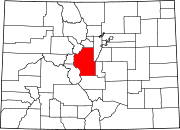Lake George, Colorado
Lake George, Colorado | |
|---|---|
 Lake George in 2018 | |
| Coordinates: 38°58′49″N 105°21′28″W / 38.98028°N 105.35778°W | |
| Country | United States |
| State | Colorado |
| County | Park[1] |
| Elevation | 7,992 ft (2,436 m) |
| Time zone | UTC-7 (MST) |
| • Summer (DST) | UTC-6 (MDT) |
| ZIP code[2] | 80827 |
| GNIS feature ID | 0191146[1] |

Lake George is an unincorporated community and a U.S. Post Office in Park County, Colorado, United States. The Lake George Post Office has the ZIP Code 80827.[2] It lies along U.S. Highway 24 northwest of Colorado Springs, and several miles north of Florissant Fossil Beds National Monument.[3]
History
About 42.3 miles (68.1 km) northwest of Colorado Springs and 7.3 miles (11.7 km) northwest of Florissant,[4] the town of Lake George was established in 1891[5] as a railroad stop for the Colorado Midland Railway (CM)[6] which had been completed in 1887.[7] The town and nearby lake—to its west and fed by the South Platte River—The man made lake was built by George Frost for the purpose of supplying ice to the railroad. The lake, originally called George's Lake was later changed to Lake George when the post office opened. The lake itself freezes mostly solid in the wintertime, which made it ideal for railroad men to cut large blocks of ice from it in order to keep perishables cool. A privately owned ice company here supplied the needs of much of the Pikes Peak region. Ice cut during the winter was shipped on the CM to both Colorado Springs and the Cripple Creek, Colorado district.[8] Also related to the town's railroading history, a short walk into the surrounding hills reveals Chinese bread ovens, from the period their labor was imported. At the turn of the century the community's population was 30.[8] After 1900 some farmers and ranchers nearby began raising high-altitude potatoes on a limited scale. This furnished the CM with some additional traffic.[8] However, the CM closed in August 1918. Other railways then provided service to certain shippers along the otherwise idle CM railway.[9] Up to that time this had been the shortest rail route through the mountains. Keeping the track open during winter proved expensive, and when the mining of ore dwindled, the tracks were torn up. U.S. Highway 24 follows the abandoned grade of the CM railway.[10] By 1941 the community had grown to 100 persons and was the center of an extensive potato growing area.[10] The community's population in 1965 was 100.[8]
In 1995, the Orthodox Church in America female monastic community of Protection of the Holy Virgin moved from Calhan to Lake George, establishing a 10.3 acre monastery. In 1999, the monastery purchased an adjacent lot of 3.5 acres and add it to the monastery's grounds. The community publishes Orthodox Christian prayer books and hosts public Divine Services.[11]
The just under-140,000-acre (570 km2) Hayman Fire, the largest fire in Colorado's recorded history, was started near Lake George on June 8, 2002.[12][13]
A tornado caused minor damage in the Lake George area on Aug. 18, 2009. An additional tornado caused damage to cabins in 2014.[14][15]
Geography
Lake George is located at 38°58′49″N 105°21′28″W / 38.98028°N 105.35778°W (38.980229,-105.357685).
Nearby is Camp Alexander,[16] the Scout camp for Pikes Peak Council, as well as the Elevenmile Reservoir.[17] Also nearby, an original homestead still stands, a remnant from potato farmers. It’s now a dude ranch called the M Lazy C Guest Ranch.

References
- ^ a b c U.S. Geological Survey Geographic Names Information System: Lake George, Colorado
- ^ a b "ZIP Code Lookup". United States Postal Service. December 28, 2006. Archived from the original (JavaScript/HTML) on November 23, 2010. Retrieved December 28, 2006.
- ^ Rand McNally. The Road Atlas '06. Chicago: Rand McNally, 2006, p. 40.
- ^ Colorado State Planning Commission (1941). Colorado: A Guide to the Highest State. Hastings House. p. 231.
- ^ "Park County, Colorado Towns & Places". Retrieved 2009-09-03. [dead link]
- ^ "Colorado Midland Railway". Archived from the original on 2012-06-30. Retrieved 2009-09-03.
- ^ Cafky, Morris (1965). Colorado Midland. Rocky Mountain Railroad Club. p. 16.
- ^ a b c d Cafky, p. 289.
{{cite book}}: Missing or empty|title=(help)CS1 maint: numeric names: authors list (link) - ^ Cafky, p. 186.
{{cite book}}: Missing or empty|title=(help)CS1 maint: numeric names: authors list (link) - ^ a b Colorado State Planning Commission, p. 231.
{{cite book}}: Missing or empty|title=(help)CS1 maint: numeric names: authors list (link) - ^ "Protection of the Holy Virgin Monastery". oca.org. Orthodox Church in America. Retrieved 31 August 2020.
- ^ "Area will take 600 years to recover from huge wildfire". Archived from the original on January 5, 2009. Retrieved 2009-09-03.
- ^ ""Lake George - A Call To Action " by Susan Lamphear". Retrieved 2009-09-03.
- ^ "Tornado touches down in Park County". Retrieved 2009-09-03.
- ^ "Tornado less than 1.5 miles away from campsite!". Archived from the original on 2008-09-10. Retrieved 2009-09-03.
- ^ "Camp Alexander". Archived from the original on 2009-05-25. Retrieved 2009-09-03.
- ^ "Elevenmile Reservoir". Retrieved 2009-09-03.

